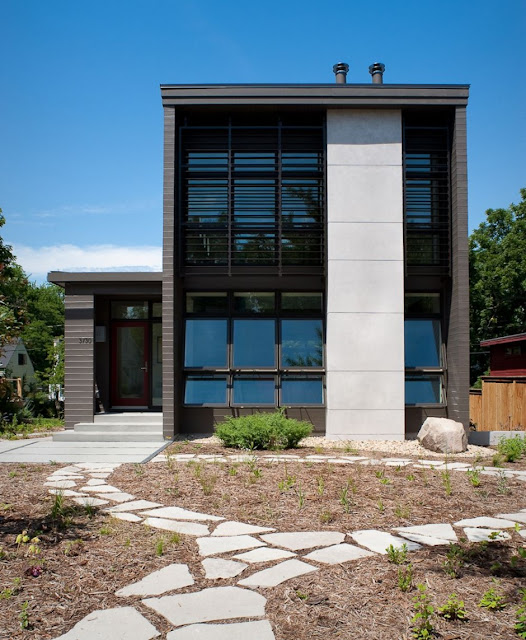Madison, Wisconsin, United States
Richard Wittschiebe Hand Architects
Post By:Kitticoon Poopong
 |
| Photo © Courtesy of Zane Williams |
Carol Richard, founding partner of the
Atlanta-based architecture firm Richard Wittschiebe Hand, returned home to Madison, Wisconsin last summer to build her house. “When I was a young architect,” says Carol, “I designed and built a house for myself in Atlanta and I’ve always wanted to build again and take advantage of the things I’ve learned over my career.” Carol’s most recent design is a collaboration with her mechanical engineer
husband, Fred Berg. Their residence, known as the Ross Street House, was recognized as
Wisconsin’s first
LEED for Homes Platinum rated residence in July 2009. The home has captured the attention of green enthusiasts throughout the country for far exceeding the requirements to achieve the highest LEED rating of Platinum. Diagrams, drawings, photographs, detailed design information and energy use analysis can be found on the website:
www.rossstreethouse.com.
 |
| Photo © Courtesy of Zane Williams |
 |
| Photo © Courtesy of Zane Williams |
The southfacing lot sits among a mix of houses in the Madison neighborhood of Glenway. Most of the homes are post world war
Cape Cod in style with a few 1960’s modern homes. The designers felt that it was important to maintain the scale and utilize familiar materials from the neighborhood. Neighboring homes were modeled so that designers were comfortable with the scale and the way the house would fit into the eclectic neighborhood. As the couple’s retirement home, it was important to them to “be a good neighbor,” so an effort was made to meet their future neighbors and talk about the design of the house before construction.
 |
| Photo © Courtesy of Zane Williams |
 |
| Photo © Courtesy of Zane Williams |
The 2,700 square foot design is a simple form with cues taken from the southfacing lot. The southern facade was designed to capture as much of the winter southern sun as possible while shading the sun in the summertime. The concept of a box camera generated the form with the roof gently sloping from south to north. Sunlight that enters the home is controlled with fixed louvers attached outside the south facing windows. Computer modeling in
ArchiCAD was utilized to study the amount of daylight that would enter the building during the winter and summer solstices. The louvers are designed to allow the sunlight to penetrate deep into the space between October and February while shading the windows between May and August.
 |
| Photo © Courtesy of Zane Williams |
 |
| Photo © Courtesy of Zane Williams |
Primary exterior materials are 6” tongue and groove cedar siding with a metal roof. Cedar siding was selected for its similar scale and material to other houses along the street. A dark color for the siding and roof were chosen so that the house would appear smaller than it actually is. In contrast, the interior materials are very light in nature. Locally harvested maple and light colored walls make the inside of the house appear larger than it is.
 |
| Photo © Courtesy of Zane Williams |
 |
| Photo © Courtesy of Zane Williams |
The main level is an open plan with service elements on the west side and living spaces on the east side. An open stair visually connects all three floors and is anchored by a three-story high wall. The upper level has a study opening onto the living room and a master bedroom suite. The lower level has additional bedrooms, a beer making room, storage, and a workroom.
 |
| Photo © Courtesy of Zane Williams |
 |
| Photo © Courtesy of Zane Williams |
Water conservation efforts include dual-flush toilets, low-flow faucets, a tankless water heater, and a rain water retention system for garden irrigation. Volatile organic compound (VOC)-free paints and adhesives were used to limit the unhealthy off-gassing commonly found in conventional American homes. The detached garage is topped with photovoltaic panels that generate enough electricity to offset more than half of the annual demand.
 |
| Photo © Courtesy of Zane Williams |
 |
| drawing Courtesy of Richard Wittschiebe Hand Architects |
The house was designed to minimize air infiltration to less than 1 air change per hour through the incorporation of spray foam insulation and the careful sealing of all doors and windows. Forced ventilation is necessary to provide healthy air in the house. This is accomplished efficiently by using an energy recovery ventilation system and incorporates a 3-stage high efficiency furnace.
 |
| Photo © Courtesy of Zane Williams |
 |
| drawing Courtesy of Richard Wittschiebe Hand Architects |
Outside the home, the front and back yards are transformed into garden spaces. An overall incorporation of native perennial plants and no turf grass make the yard low-maintenance. A rain garden and vegetable garden are located in the back yard next to the detached garage. A rainwater collection and retention system that stores 650-gallons of water is stored below the back porch. Pervious paving and limited impervious hardscaping for the driveway and walkways were used.
 |
| drawing Courtesy of Richard Wittschiebe Hand Architects |
 |
| drawing Courtesy of Richard Wittschiebe Hand Architects |
 |
| drawing Courtesy of Richard Wittschiebe Hand Architects |
 |
| drawing Courtesy of Richard Wittschiebe Hand Architects |
 |
| drawing Courtesy of Richard Wittschiebe Hand Architects |
 |
| drawing Courtesy of Richard Wittschiebe Hand Architects |
 |
| drawing Courtesy of Richard Wittschiebe Hand Architects |

 |
| drawing Courtesy of Richard Wittschiebe Hand Architects |
 |
| drawing Courtesy of Richard Wittschiebe Hand Architects |
 |
| drawing Courtesy of Richard Wittschiebe Hand Architects |
 |
| drawing Courtesy of Richard Wittschiebe Hand Architects |
The people
Architects: Richard Wittschiebe Hand Architects
Location: Madison, Wisconsin, United States
Photographs: Zane Williams
via:contemporist


























